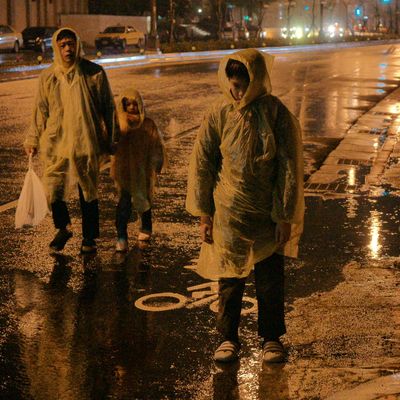
Tsai Ming-liang’s Stray Dogs is not billed as a horror film, but it might as well be. Opening with an ominous, hypnotic, and perplexing image of a woman slowly brushing her hair while two kids snooze beside her, this amazing, maddening film presents a series of extended, mostly static, terrifying tableaux of despair, poverty, and decay. The lengthy, locked-down images contain a tension all their own — like that aforementioned first shot, whose meaning remains just out of our grasp. Sometimes Tsai fixes his camera on an actor and lets us watch them up close for impossibly long periods of time, as if challenging the performer. But, in fact, he’s challenging us — not so much our patience (though he’s challenging that, too), but our ability to live with the uncertainty of his otherwise concrete images.
There is a plot to Stray Dogs, but it’s spare and tenuous, and you could have a quick chuckle reading various reviews to see how different writers interpret it. A father (Tsai regular Lee Kang-sheng) and his two kids live in abject poverty on the outskirts of Taipei. Dad, an alcoholic and a depressive, is a haunted, quiet guy. Something, or some things, have broken him. He holds up real-estate signs for a living, standing still at the edge of busy intersections for hours on end, pretty much the perfect job for a Tsai Ming-liang character. The two kids wander cheerfully on their own, often passing the time and eating the samples at a local supermarket, where a female clerk seems to take an interest in them. Does she know them? We’re not sure. At nights, the woman wanders abandoned lots feeding stray dogs. She also seems to be looking for something. Is she looking for the kids?
Stray Dogs is the kind of film that teases you with a narrative; it makes just enough sense that you want to piece it all together, even though the film resists easy resolution. A third-act turn in particular leaves us wondering if we’ve jumped forward in time, or backwards — whether we’re seeing a new stage in the characters’ desolation or a glimpse of what helped bring them to this moment. At one point, the kids dress a head of cabbage with lipstick and fake hair and slip it into bed beside their father; what he then drunkenly does to the cabbage is by turns hilarious, pathetic, unsettling, and horrifying, leaving us with a million more questions than before. There’s a real eerie quality to the film’s slipperiness. It’s unnatural, almost uncanny: The more we watch these people, the less we understand them.
Luckily, we’re in the care of a master. Tsai is renowned for his audaciously controlled, static shots; in the 2001 comedy What Time Is It Over There? he practically turned his aesthetic into a running gag. And his work has become even more experimental and installationlike over the years. I counted fewer than 80 shots in all of Stray Dogs, each gorgeous and immersive and bewildering in its own way. The power of the director’s cinema lies in its aural and tactile quality — and that’s where we might find a hint of a meaning. If I had to find one word to describe Stray Dogs, it would be cavernous. There is no warmth to be found anywhere in the film. Even the one nice house we see is cold and vast. The impoverished characters are often at the mercy of the elements – the driving rain that pounds their ramshackle bedroom, or the howling wind that blasts Dad at work on that Taipei street, or the huge, chilling blackness of night.
But even when the characters find safety and shelter, the elements are there. Late in the film, we see everyone tucked away cozily in what is best described as a house made of rain, whose walls have melted and molded over from the water (someone says the house is “crying”). Right near the end, in the film’s most audacious static shot, two characters stand in a decaying room surrounded by rocks — looking at a giant painting of rocks. Have they entered the painting, or has the painting burst through its frame? Does it matter? Despair is its own ecosystem, the director seems to say; it won’t leave you alone even if you have a roof over your head. I’m still shivering.


